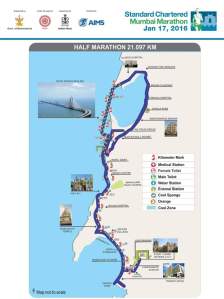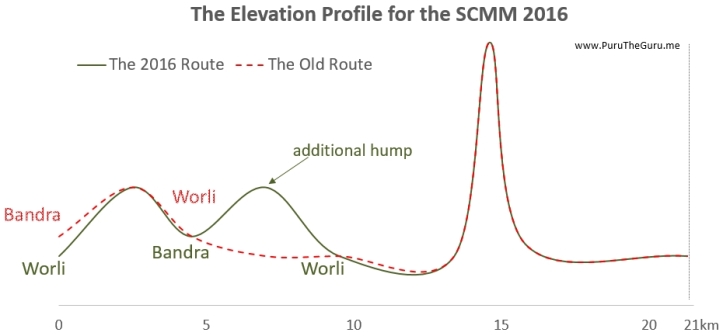
The Standard Chartered Mumbai Marathon 2016 is now exactly a month away, on 17th January. If you ran the half marathon there in previous years and are repeating the challenge, the change to the route along with the new start point might have raised a few questions.

Let us hope that the event logistics around the route change will be handled well for your enjoyment. What I can discuss is issues around your actual run effort. Here is my take on the route changes and a plan you could follow for achieving your target time this year.
The change in elevation profile
The primary concern that you might have is that the route will be tougher this year. The elevation profile has changed thanks to a loop of the city’s iconic Bandra-Worli Sea-Link. In earlier years we ran in only one direction, from Bandra to Worli. This year we will start from Worli and run from Worli to Bandra on the Sea Link and then return back to Worli on the Sea Link. We then continue towards Haji Ali but our run on the relatively flat roads of Prabhadevi and Worli will be shorter this time.

How much tougher?
I have played around with simulations on my computer model of the route, its elevation profile and a range of runner abilities, and my estimate is that the run will be about 1.5% tougher this year. (The range is likely to be 1%-3%.) You might be thinking, “Hmmmm… just 1.5%…that does not sound like much… right?” But, that isn’t really true. For a 2-hour runner, that 1.5% is about 1-min 48-sec. It could take you from 1:58:30 to 2:00:18 and ruin your chances of a Sub-2. Worth thinking about the details, eh?
Negative splits possible.
You have run a ‘negative splits’ race when your second half is faster than the first – not rare for experienced runners. For most recreational runners, even on a flat course, the converse is true, ‘positive splits’, i.e. a slower second half. Given the change in elevation profile, your probability of achieving negative splits increases with the new route. All other things remaining the same, your total time will be slower on the new route, but the split between first and second halves can be reversed from a slower second half (positive splits) to a faster one (negative splits)! This increased probability of negative splits all depends on the type of runner you are, including your absolute level of fitness and also your level of preparedness. Of course, you might not even care about your splits – which is also perfectly OK! I expect the majority of runners to have positive splits on this new course too.
Pacing yourself for a Sub-2

Although only about 10% of entrants finish the half marathon in under 2 hours, I would like to present you with a pacing plan for doing so. The one I did here for 2015 is also worth reading. This time, I take the case of two runners:
a) The Strong runner – she will finish in 1:58:00 with negative splits (second half faster than the first) running a faster leg near the finish, with a generally steady pace throughout, including the hills.
b) The Volatile runner – he will finish in 1:59:00 with positive splits (second half slower than the first) running a slower leg near the finish, with a generally weakening pace and greater variation up and down the hills.
Both runners have a tendency to slow down as the kilometers roll by, but this effect is less so with the stronger runner. As you will have seen in previous articles on pacing yourself like the one above or for Hyderabad I allow for a little extra distance than the headline 21.1km. If you have a Sub-2 target, use this table on race day, it will not fail you if you have trained well.
In case you are looking forward to running with a pacer at SCMM-2016, then it will be worth your while to also read about that in my guide to pacing and choosing pacers. Let us also hope that there is greater success among the pacers themselves and lessons have been learnt from SCMM-2015.
With the days rolling by, if this is your main race of the season, you will be looking to reach peak performance on race day. Reaching that level and maintaining it until the race is not an easy challenge. But meeting that challenge successfully will increase your maturity as a runner, And finally, remember, once your race is done, you could give some thought to why you need not run!
Dr Purnendu Nath spends his waking hours focusing on helping individuals and organizations reach their goals, to make the world a better place. He speaks, writes and advises on topics such as finance, investment management, discipline, education, self-improvement, exercise, nutrition, health and fitness, leadership and parenting.


You are absolutely unbelievable !
You control the hearts and minds of your readers !
You live in the minds of your readers before you write your blog. Understanding absolutely as to what they must be thinking and what must be really worrying them.
Then you write with such an impact about every minute detail that you enter their hearts straightway !!
This 1.5 % bit got me totally. I fell for it hook, line and sinker !
Majestic way of catching someone’s attention. And then every so often,referencing your previous blogs that read in conjunction to the view being expressed , provided a 360 degree perspective !!
Trained economist , you have started writing like John Grisham !
Please do a special piece for runners in 2:30 category.
LikeLike
Ravi… thank you… for the flattery… again!
About the 2:30, I shall try… semi-promise!
LikeLike
Very informative and detailed. Planning to run my first full marathon this scmm. It would be great to read your thoughts on running full marathon. Thanks
LikeLike
Dear Kamal, I have many useful and useless thoughts on running a full marathon. For today, my advice to you specifically for your (first) full is “Do it easy, do the distance, don’t worry about the time taken for your first full. If you consciously target a slower first half, you will have a strong finish, without injuries, a smile on your face and beautiful photos at the finish line. Race #2 – that’s a different story!” Good luck, God speed!
LikeLiked by 1 person
Interesting article as ever, Guruji, but I am curious about your calculations. The new route includes one extra traverse of a flattish bridge, not repeated climbs of Mount Mary… 🙂
The elevation scale on your elevation profile graph is unlabelled, but given my Garmin tells me Peddar Road adds around 30m of ascent (from around 10m to 40m elevation), I would estimate that the new Worli-Bandra route adds just 10-15m of ascent, gained very gradually over about 2.5km (ie average slope about 0.5%, for around one tenth of the total race distance). There is of course some time gain in the extra descent, though admittedly this does not offset the ascent.
So, all in all, does this really equate to 1-3% slower race time? I’m interested in how you arrived at this figure. There’s a relatively high uncertainty in your range too 🙂
To contrast, my anecdotal experience at the Satara half marathon (410m of ascent gained over around 9km) was that race times were “only” typically 10% slower than compared with an average flattish course.
LikeLike
Dear Philip
On that elevation profile graph, the vertical axis (like the horizontal) is to scale (specifically) along that dimension. So, the top of Pedder Road is 87m above (what I call) “sea level” whereas the top of the Sea Link is at an altitude of 28m (and now we run this twice). Within this model, along with a time (actually, distance, to be precise) trend, which will be almost zero for an elite runner and noticeable for a novice, I also model a slower (faster) pace for an uphill (downhill). The degree of slowing down (speeding up) is a function of the angle of the slope (i.e. slow down more for a steeper uphill). Also, runners vary in the way they tackle a slope (regardless of fitness levels). Not all runners do it by approximately constant effort (my advice!) and so will not slow down as much as they ought to on an uphill. And, finally, stronger runners have faster times in the last 5km than in the first 5km. The converse is the case for the less well-trained runners. Putting all those together, the range is about that much 1%-3%.
With regards to Satara, I don’t have the data for that, but would love to analyze it if you can reach it to me in machine-readable form. I would also like you to look at https://purutheguru.me/2015/07/16/mumbai-vs-delhi-a-race-time-model/ where I show that comparing one race versus another ought not to be done with a single number conclusion as is often presented when ranking a race. Any comparison needs to have “absolute race time” as an explanatory variable too.
Thank you for your questions. I hope the explanation helps.
Regards
Puru
LikeLike
Thanks for your constructive reply, Puru – I appreciate you taking the time to elaborate here. To clarify, I’m not so much questioning how your model works – it’s clear you’ve thought carefully about this and your assumptions seem sensible. However, I am still a bit doubtful about some of the parameters you are hard-coding into the model. Specifically, you say “…the top of Pedder Road is 87m above (what I call) “sea level”…”. However, using two different GPS watches the altitude information I have indicates the bottom of Pedder Road is at about 10m altitude, and the highest point around 42m altitude. This is quite a difference from the 87m you quote. Indeed, all the information I can find online says the highest point of Malabar Hill (which is of course higher than Pedder Road) is only 50m above sea level. I’m not meaning to be overly picky here – just trying to clarify so that all information presented is as accurate, hence as useful, as possible.
LikeLike
Hi Philip!
“Overly Picky” is good – that’s how we initiate change, so I’m glad you are questioning. I am going only by Garmin records that I have. In fact, even Garmins don’t always give the same numbers. The 87m you see me quote is from my SCMM-2015 run. I also have records for previous runs that state higher figures, and I have ones that are less. I shall stick with 87m for now as it is internally consistent with the Sea Link reading. You too would like my model to be realistic rather than be implicitly conservative. Having said that, if there is a bias, it’s probably best in this particular case to err on the side of having a slightly higher altitude. Finally, given what I have done, within a specific setting, as long as my ratios of altitude (e.g. Sea Link : Peddar) on the altitude scale remain the same, the results should be almost the same.
If you have more to say, I would like to hear from you.
Hope you make it home for a fantastic X’mas.
Cheers!
-Puru (19-Dec-2015)
Hi Philip!
I’ve reworked the model, including the elevation numbers (have collected a lot of noisy data!) and the results for the 2 model runners need not change much at all.
I’m reworking numbers for a bunch of other finish times in a richer model setting and will publish those in an even more useful format soon – for both the half and the full.
Merry X’mas!
– Puru (23-Dec-2015)
LikeLike
Puru… Very nicely put… I was thinking the same thing.
As earlier when you Started, You would get a mild upward incline from Toll till 1/4 of the Sealink..then nice long downward Incline for 3/4th of the distance… Now that 3/4th of the distance will be an Mild uphill… compared to the flatter loop we used to do at Old passport office… But we will get the Same Downhill also again, But since this all will be happening in the First Half of the Marathon we need to make sure we save our energies & maintain a consistent pace .
So for strong runners.. this might definately not make a difference, But for us and finishers at borderline of each time.. they definately need to look into it…
And the problem is since we have never been able to do a trial run .. non strong runners like me wouldn’t know the toll the extra effort takes on us… So I think its safe to do our Trial Long 21.3 as I am targeting sub 2:15 , trial should be about 2:11 to take that 1~3% extra time.
Best regds
Dipen
LikeLike
I am planning to run a sub 2 at SCMM. The tips and info about the new route is really helpful. Thank you very much.
LikeLike
wow. great post. Make me proud #1 fan.
LikeLike
[…] the last few years, as a 2-hour pacer, I’ve had many of you achieve your personal best or first sub-2 in the half. I also told you in an earlier conversation why I do not really care about a podium finish (yours […]
LikeLike
[…] years of the SCMM, as a 2-hour pacer, I’ve had many of you achieve your personal best or first sub-2 in the half. I also told you in an earlier conversation why I do not really care about a podium finish (yours […]
LikeLike
[…] the changed route for the Half Marathon was announced for 2016 I spoke to you about the challenges. My estimate then was that it would add between 1%-3% to your race time. Given that the Heat Index […]
LikeLike
Hi. Is the pacepal app based pacing still relevant for the 2017 full marathon route? (I know the HM routes were changed in 2016 – I’m not sure about the FM).
Thank you.
LikeLike
The route is mostly the same… but… the app might no longer be available, and in any case you should be using the pacing bands here
https://purutheguru.me/2017/01/01/scmm-2017-free-gifts/
LikeLike
Thanks Puru. The bands are fantastic and thanks for putting them together. I have just one reason I prefer pacepal. It gives me fewer distance blocks with a corresponding target pace. I can feed those in as a preset workout in garmin with a “pace range”, which will buzz real time if I’m falling outside either way.
The band works brilliantly for someone running with even a simple stop watch (or a smart tracker watch) and able to compare every km how he’s stacking up against his time target.
LikeLike